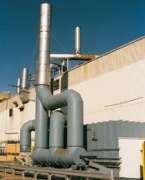Destroying Your VOCs
Installing a twin-bed regenerative thermal oxidizer has reduced Easco's VOC emissions…
#pollutioncontrol
About two years ago, Easco Aluminum began a major renovation of its Girard, Ohio, operation with the hiring of a new management team. As part of the renovation, the management team wanted to equip the plant with state-of-the-art pollution control technology, even though the company was well within environmental regulations. The goal was to ensure that the company was impacting the local environment as little as possible and show that it was a good corporate citizen.
Easco has 10 aluminum extrusion plants scattered throughout the country. The plant in Girard manufactures aluminum extrusions, primarily for the home building and construction industries. These extrusions are then coated on one of two vertical electrostatic paint lines (up to 24 ft) with solvent-borne paints.
Featured Content
Since uncoated aluminum provides good corrosion resistance, the solvent-borne paints are mainly applied for cosmetic reasons. Roughly two-thirds of the solvent-borne paint that Easco uses is an acrylic, the balance is a fluoropolymer and a polyester material. In the mid-'80s, the company was pushed to increase its use of polyester paints to meet the required VOC emission limits. However, the company decided to stick with acrylics because of their ease of application and installed the necessary air abatement equipment.
In 1986, Easco installed a recuperative thermal oxidizer to destroy the VOCs from the painting operation. The destruction efficiency of this unit was about 60%. When the new management team took over, it no longer felt that this oxidizer was state-of-the-art pollution control technology.
Therefore, in 1997, Easco installed a 25,000-cfm twin-bed Model 25 Roxidizer® regenerative thermal oxidizer (RTO) and air volume reduction system from Tellkamp Systems, Inc. Easco chose this RTO because it had previous success with similar units at its Connecticut, North Carolina and Ohio facilities. The special design of this RTO has not only allowed the company to increase its destruction efficiency (up to 98 to 99%), it has also reduced the amount of energy required for operation and reduced the amount of air that must be cleaned.
How does the system do all this? It starts with the air volume reduction system. Solvent-laden air from the paint line is fed into the air volume reduction system where the air passes through a filter to remove large particulates. A large portion of the filtered air is recirculated to the paint booth while the rest is sent on to the RTO. This provides Easco with two significant benefits: 1) Easco is required to clean a smaller volume of air, which means a smaller RTO; and 2) The efficiency of the process is increased, since the air that enters the RTO has a higher solvent concentration.
Once it has passed through the air volume reduction system, the solvent-laden air moves on to the twin-bed RTO. When the contaminated process air enters the RTO, it rises through one of the two heat exchange beds, which contain a honeycomb-shaped ceramic media. The ceramic media heats the solvent-laden air before it enters the horizontal combustion chamber. By the time the air reaches the top of the ceramic bed, most of the VOCs have reached their auto-ignition temperature. The process air is then maintained in the combustion chamber at the minimum operating temperature (typically 1,450F) for a set period of time to complete the oxidation process.
The clean, hot process air then descends through the second heat exchange bed. As the air passes through the honeycomb-shaped ceramic media, it releases its heat to the media. The cooled air is then exhausted. When the ceramic media in the first bed is no longer able to heat the contaminated air to the required temperature, a paddle in the entry pipe shifts to direct the air to the second bed, where it can be preheated before entering the combustion chamber. At Easco, this happens about every two to four min. Because the ceramic heat exchanger is 95% thermally efficient, the exhaust air is only 60 to 70F hotter than the air that enters the RTO.
The honeycomb-shaped ceramic media and twin-bed design have also provided Easco with several advantages. Unlike its current RTO, Easco's previous oxidizer used half-moon ceramic media. The half-moon ceramic media forced the air to flow in a zigzag pattern. However, the honeycomb-shaped ceramic media allows the air to flow in virtually a straight line. Because the air basically flows in a straight line, less horsepower is needed to push or pull the air through the heat exchange bed. Also, the twin-bed design reduces the amount of fuel Easco needs to destroy the VOCs from the paint line. This is due to the clean air preheating the ceramic media. The heat from the ceramic media is then used to heat the solvent-laden air before it enters the burner.
Easco has realized these benefits because its management team was not satisfied with merely meeting regulatory requirements. Instead of focusing on the environmental regulations, the company sought out the best available technology to improve its operation. And that shows that striving to be the best will win out in the long run.
To learn more visit Tellkamp Systems, Inc..
RELATED CONTENT
-
Treating Plating Wastewater
Wastewater from plating facilities contains contaminants such as heavy metals, oil and grease and suspended solids at levels that might be considered environmentally hazardous . . .
-
NOx Scrubbing Technology Breakthrough
This paper presents research findings and practical results that address the treatment of the problematic greenhouse gases nitrogen oxides (NOx) and sulfur dioxide (SO2).
-
Recovery/Recycling Methods for Metal Finishers
A guide to lowering pollution and recovering valuable process constituents.


.JPG;width=70;height=70;mode=crop)


















